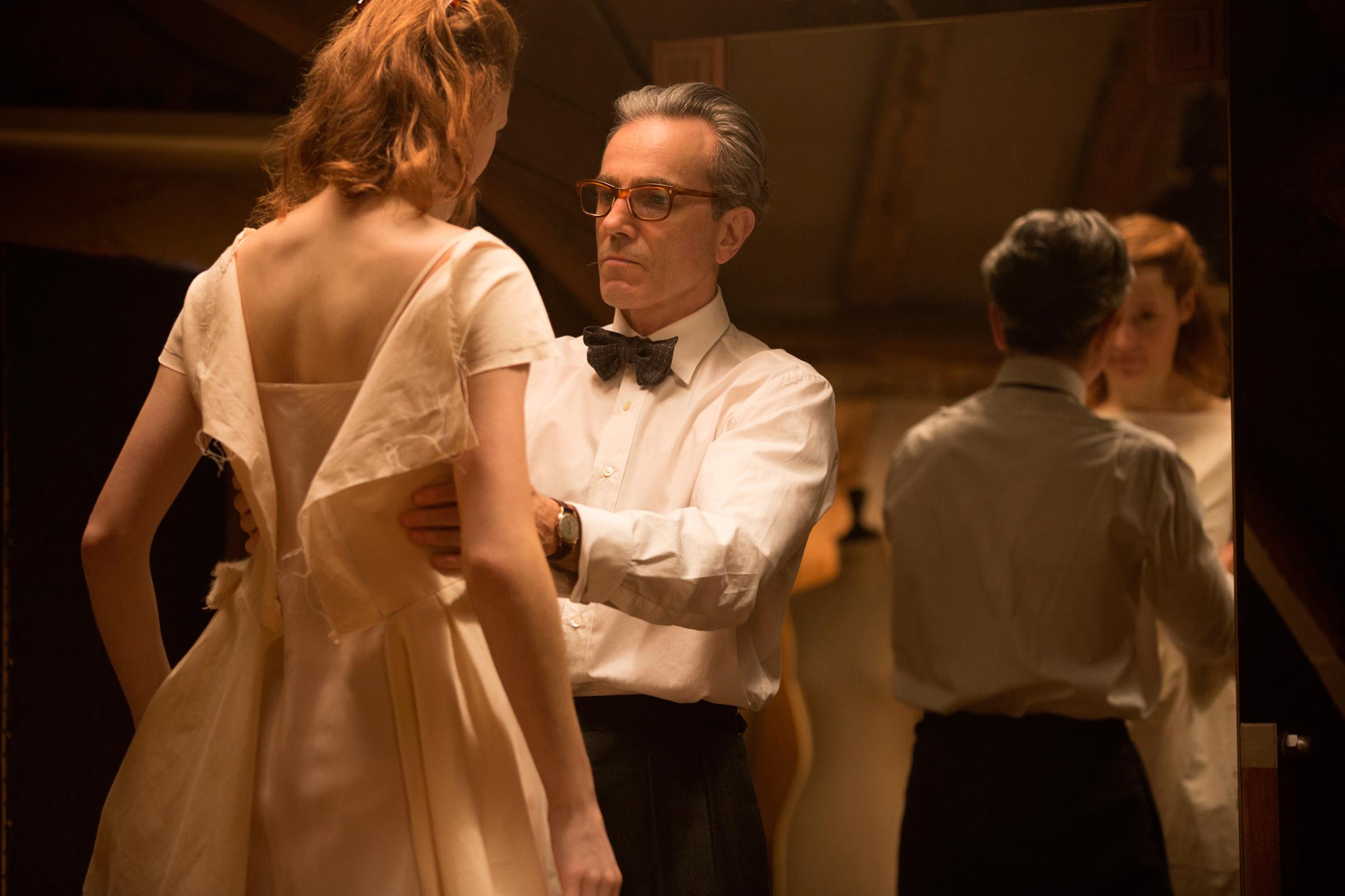The quality that makes Daniel Day-Lewis a great actor–that aura you see so clearly onscreen yet can’t quite put your finger on–may be this: no matter what he’s saying or doing, whether he’s standing or walking or even, as in The Last of the Mohicans, running so magnificently through the forest in buckskin trousers, his eyes and his body language impart a whispered secret. It sounds a little like, “I could throw this all away at any minute.”
That’s why Day-Lewis’ upcoming performance in Paul Thomas Anderson’s Phantom Thread is an eagerly awaited event. Anderson’s movie is one of the biggest holiday releases, and also one of the most mysterious: few details about it have been revealed, although we do know that Day-Lewis plays a fictitious 1950s-era English couturier by the name of Reynolds Woodcock, a man who looks, from the movie’s trailer, to be both demanding and dangerously seductive. A Day-Lewis performance is always something to look forward to, because there aren’t that many of them; he has always chosen roles carefully. But this particular turn comes loaded with even more intrigue than usual: in June, Day-Lewis announced that his role in Phantom Thread would be his last.
Day-Lewis has thrown it all away before, or at least temporarily given it up. In the late 1990s, he retreated with his family to Italy, where he apprenticed with a Florentine shoemaker for nearly a year. He didn’t resurface until Martin Scorsese’s 2002 Gangs of New York. In fact, Day-Lewis, who is 60, is so choosy about projects–he last appeared in Steven Spielberg’s 2012 Lincoln–that you could almost argue that he’s been semi-retiring off and on for much of his career.
But if Day-Lewis really is retiring for good–possibly to spend more time woodworking, which he has said he loves, or even just puttering around the house in classic retiree style–that only confirms the rarity of his spark. Most of us first fell for him as Johnny, the not-so-tough neighborhood tough of Stephen Frears’ 1985 My Beautiful Laundrette. With his peroxide-tipped hair and T-square cheekbones, Day-Lewis’ Johnny was sexual glamour in overdrive, a scrapper sauntering through life just for kicks, yet knowing enough to stop for what matters. As the artist and writer Christy Brown in Jim Sheridan’s 1989 My Left Foot, he played a man, not a disability–even to call the character “wheelchair-bound” does this fierce yet infinitely delicate performance a disservice.

In approaching a role, Day-Lewis favors Method-acting preparation techniques. To play James Fenimore Cooper’s heroic trapper Hawkeye in Michael Mann’s 1992 The Last of the Mohicans, he spent time building canoes and tracking and skinning animals. But the subtlety of the results is what really matters. Day-Lewis is the only performer to have won three Oscars for Best Actor, for My Left Foot, There Will Be Blood and Lincoln. But his showiest performances, like the one he gave as Daniel Plainview, the poisonously bitter oil magnate of Anderson’s There Will Be Blood, aren’t necessarily his best, even when they garner awards. Day-Lewis’ Plainview feels more painstakingly whittled than genuinely felt. It’s acting you can see, which isn’t necessarily the same as great acting.
But much more often Day-Lewis sinks like a specter into his characters–he’s visible and yet not. He made a superb Abraham Lincoln, gentle-hearted and melancholy. As the exceedingly proper yet passionate New York lawyer Newland Archer in Scorsese’s 1993 The Age of Innocence, it was as if he had absorbed the mood of Edith Wharton’s luminous, wistful novel through his skin.
What kind of performance will Day-Lewis give in Phantom Thread? Reynolds Woodcock appears to have been modeled on Charles James, whose observant eye and architectural precision made him one of the most extraordinary designers of the past century. A Charles James gown–it could be made of the stiffest silk draped into graceful arcs like a seashell, or of chiffon pleated as finely as the gills of a mushroom–is a touchable miracle of color and formality, of movement and soul. If it’s possible to subsume those qualities into a performance, Day-Lewis is our man. Holiday releases have long been a big deal in the movie business, representing the pre-Oscar rollout of films the studios are most eager to show off. It’s fitting that Day-Lewis may be making his grand exit in a big ball gown of a movie, leaving just a rustling of grandeur and mystery in his wake.
More Must-Reads From TIME
- The 100 Most Influential People of 2024
- The Revolution of Yulia Navalnaya
- 6 Compliments That Land Every Time
- What's the Deal With the Bitcoin Halving?
- If You're Dating Right Now , You're Brave: Column
- The AI That Could Heal a Divided Internet
- Fallout Is a Brilliant Model for the Future of Video Game Adaptations
- Want Weekly Recs on What to Watch, Read, and More? Sign Up for Worth Your Time
Contact us at letters@time.com